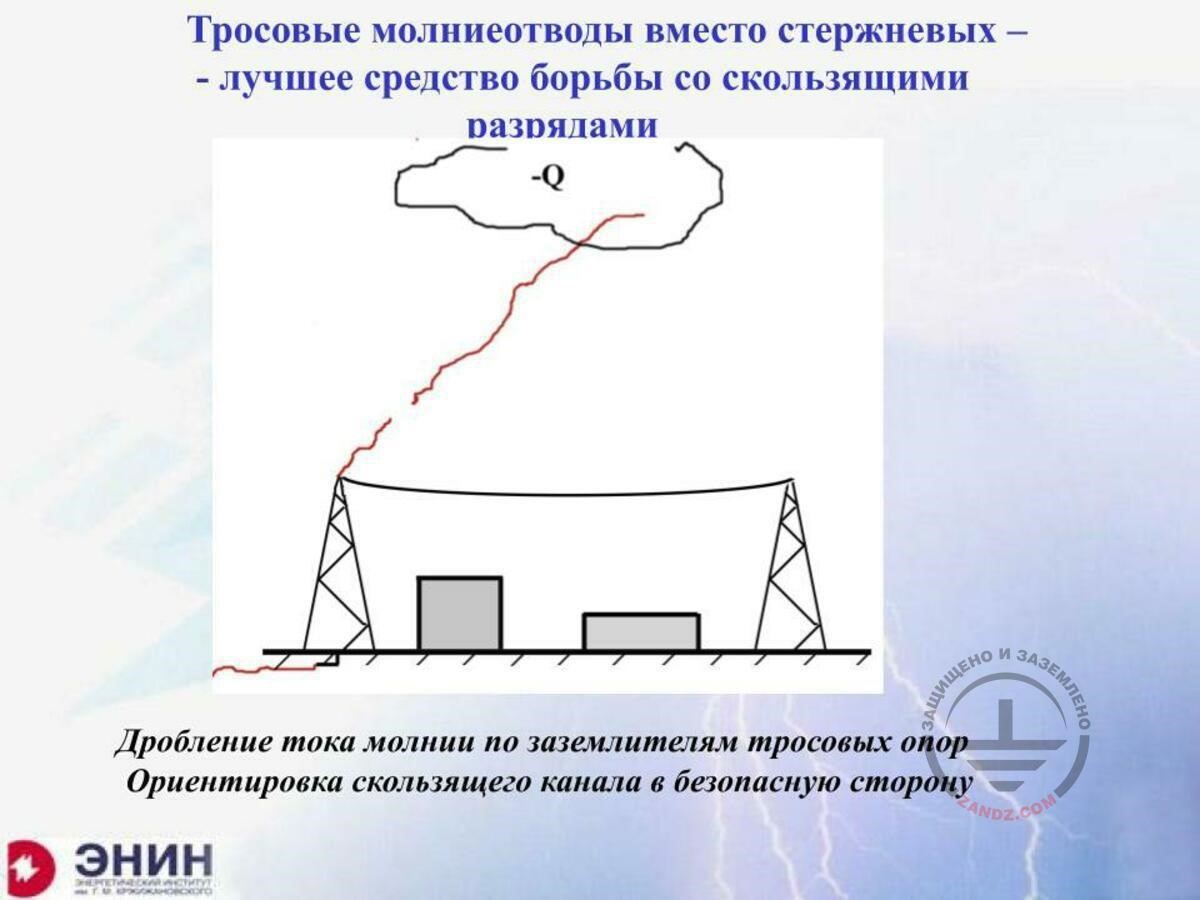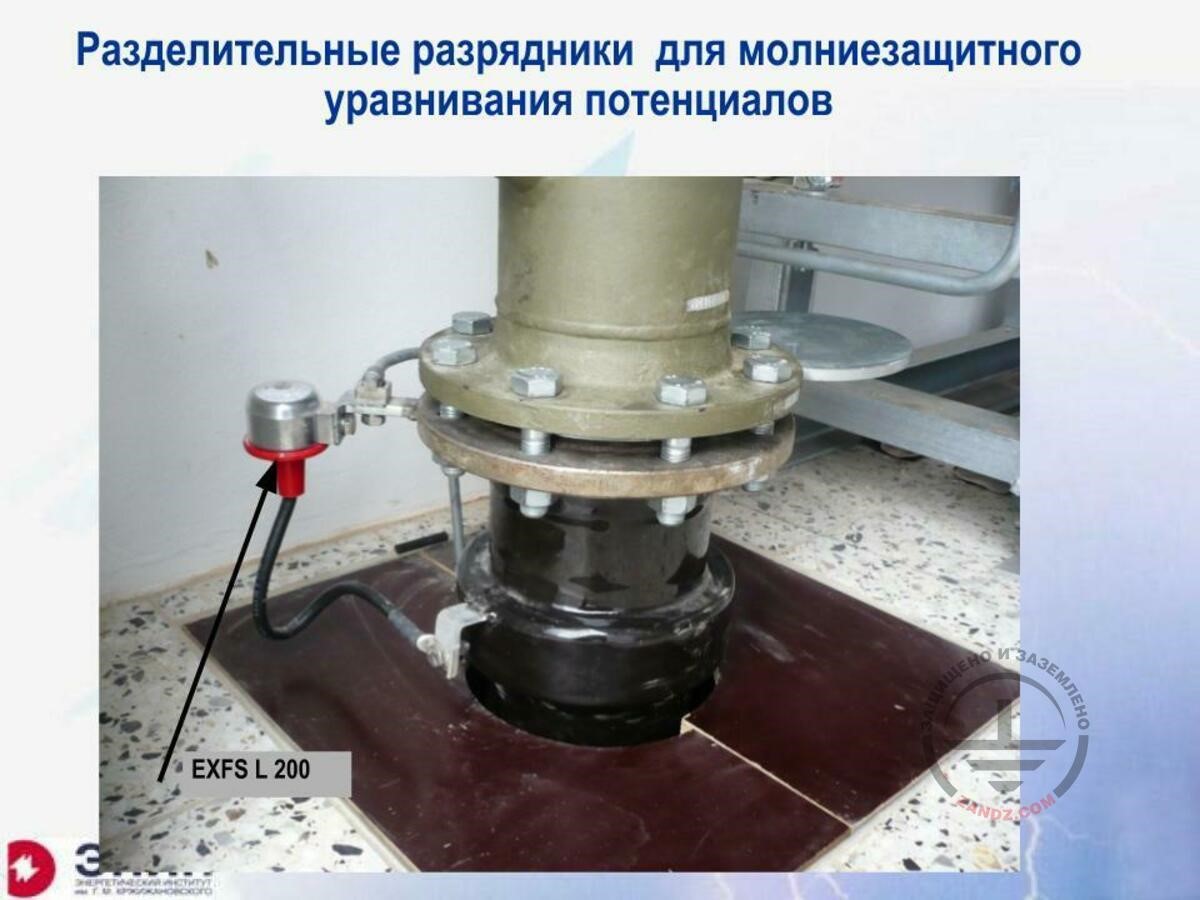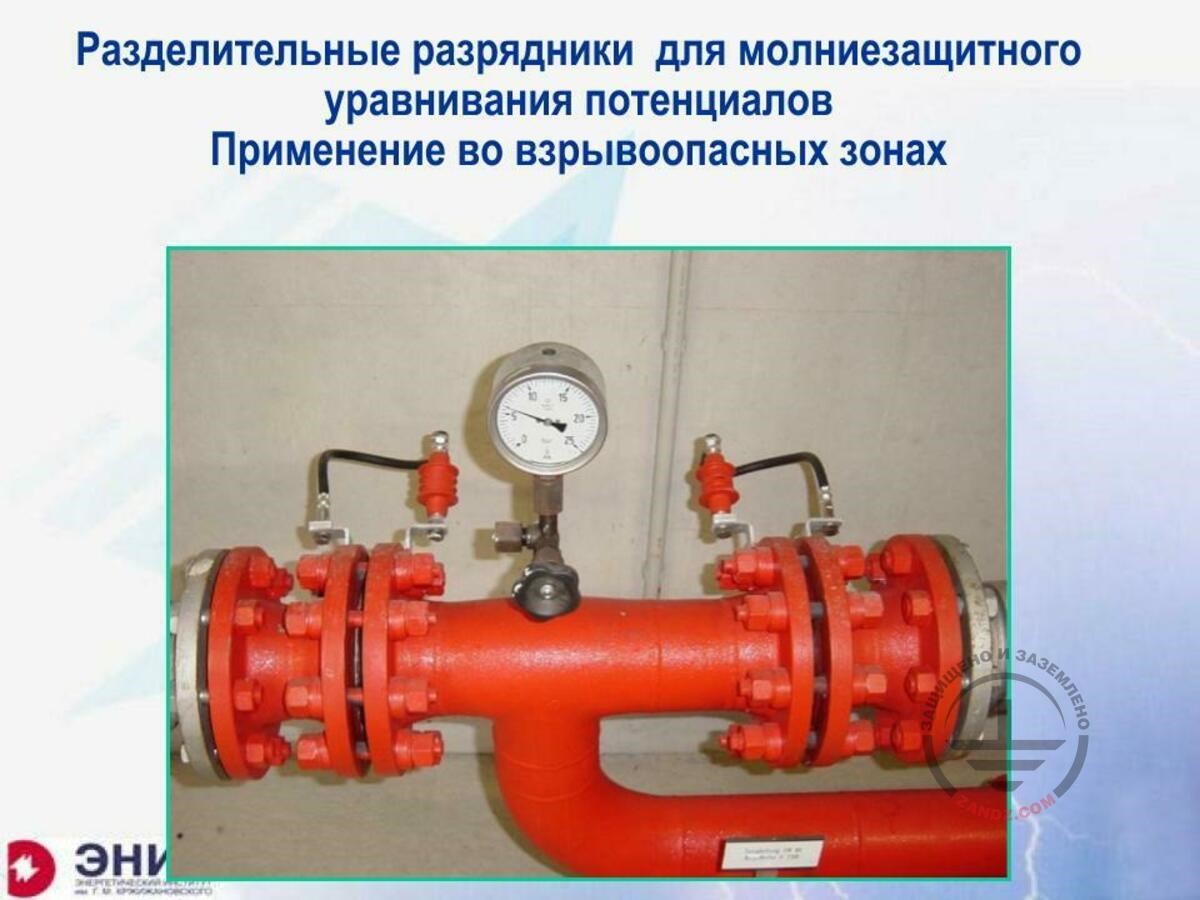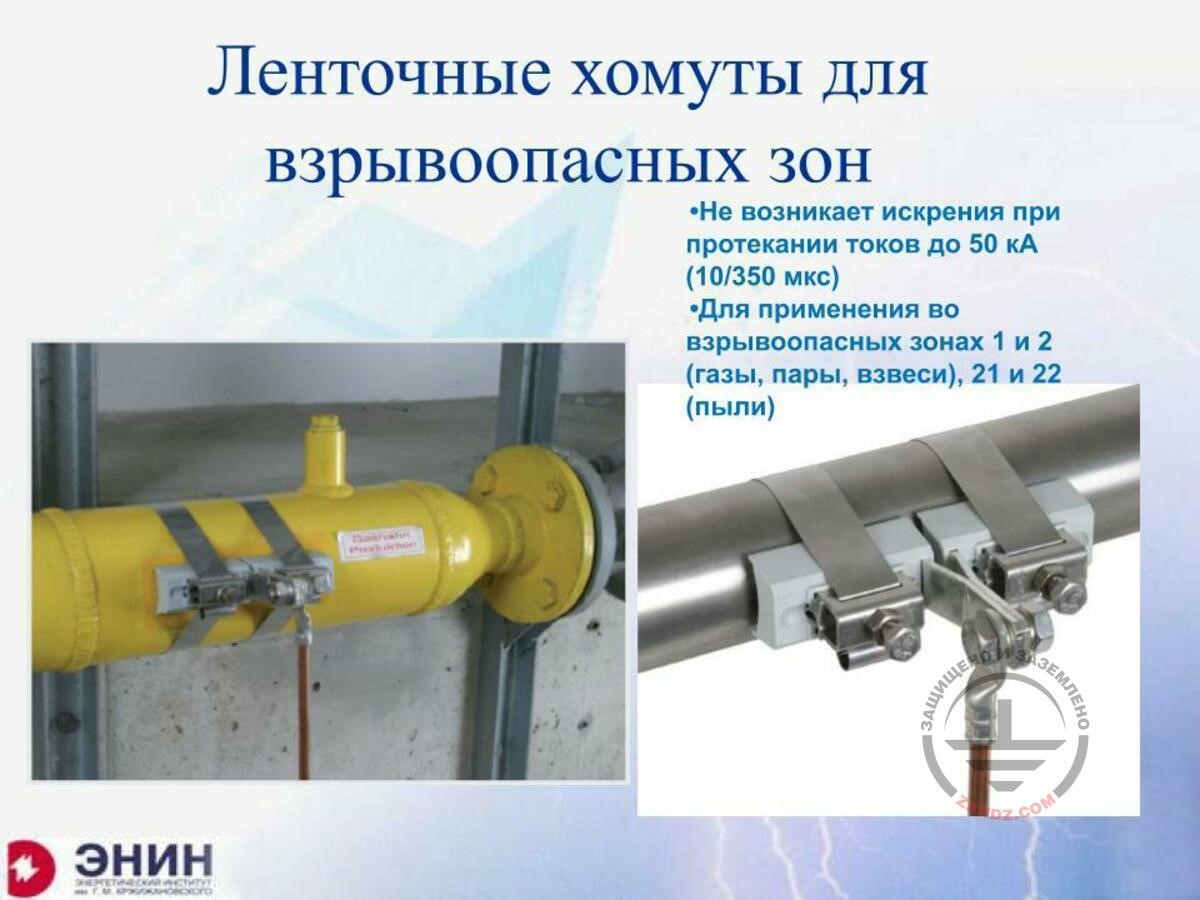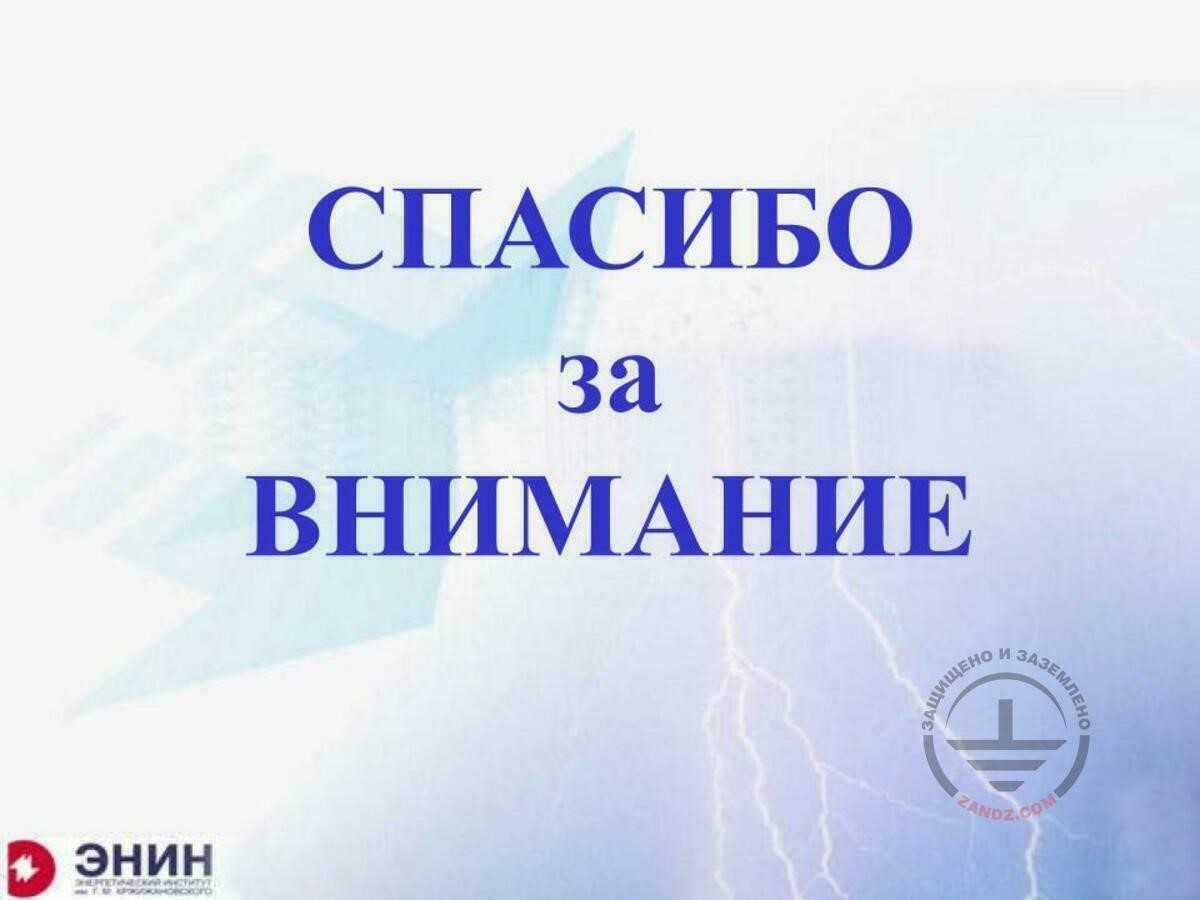Webinar text. Page 3
Fast navigation by slides:
<< Page 1:
1. Fire safety
2. Lightning parameters
3. Lightning is a poor fire-setter!
4. Rated parameters
5. Lightning energy as a whole
6. Thermal impact of lightning current
7. Emergency mode: one current collector is damaged
8. Welding is preferred to contact connections
9. Tip of the Ostankino Tower
<
10. Spark discharges along the soil surface
11. Incomplete discharges
12. What discharge may put the gaseous mixture on fire?
13. Regulatory requirements
14. Multiple lightning arresters
15. Standalone lightning arresters
16. Lightning protection issues
17. Category III lightning protection
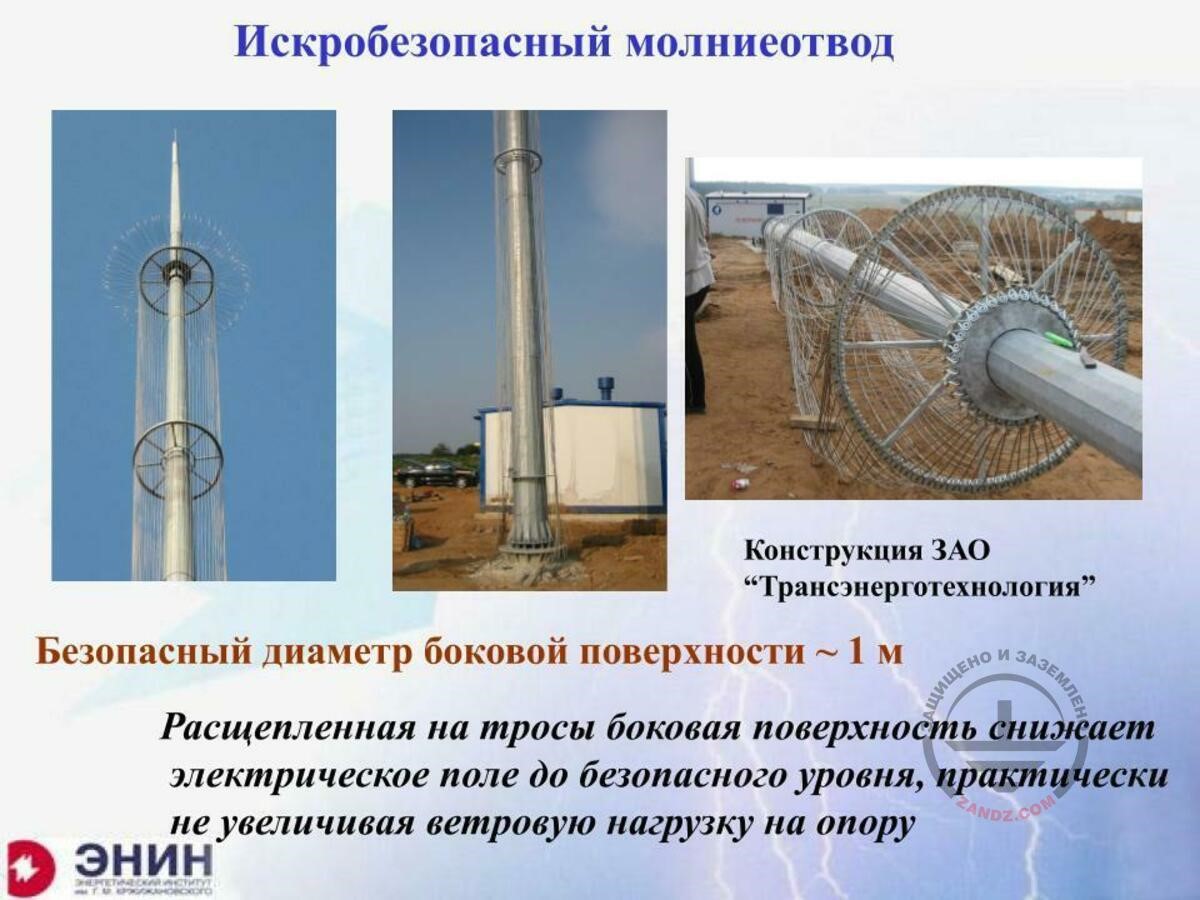
Spark-proof lightning arrester
| Искробезопасный молниеотвод | Spark-proof lightning arrester |
| Конструкция ЗАО «Трансэнерготехнология» | Structure of “Transenergotechnology” ZAO |
| Безопасный диаметр боковой поверхности ~ 1 м | Safe diameter of a side surface ~ 1 m |
| Расщепленная на тросы боковая поверхность снижает электрическое поле до безопасного уровня, практически не увеличивая ветровую нагрузку на опору | A side surface split into wires reduces the electrical field to the safe level, while virtually not increasing the wind load on the support |
| Тросовые молниеотводы вместо стержневых - | Wire lightning arresters instead of rod arresters - |
| - лучшее средство борьбы со скользящими разрядами | is the best way to struggle the creeping charges |
| Дробление тока молнии по заземлителям тросовых опор | Lightning current splitting among the earthing devices of the wire supports |
| Ориентировка скользящего канала в безопасную сторону | Orientation of a creeping channel to the safe side |
The idea of using wire lightning arresters instead of lightning rods, especially in the explosive or fire hazardous facilities has a good potential. It is rather good for the following reasons. Look what happens if you take a wire lightning arrester. You have got several advantages. The first benefit is when you have at least one wire lightning arrester, it has two supports. And if it has two supports, then the lightning current will flow in both supports. And it means that the current in each earthing device will reduce 2-fold. It will become twice lower and the spark channels that flow from the earthing devices of these supports will become twice shorter. It is the first aspect. The second aspect: I can make an oriented earthing device by directing it away from the explosive territory. And then my spark discharge will go to the safer side. And such charge spread to the safer side will reduce the fire risk dramatically. And finally, there is the third aspect. With other conditions being equal, the wire lightning arresters provide a more efficient protection than the lightning rods. Especially if you have a multi-wire lightning protection system that provides a shielding effect due to the crown charge from it. These factors in aggregate provide greater benefits of wire lightning arresters if you protect the explosive and fire-hazardous facilities. We are talking primarily about the tank farms. There, the wire lightning arresters are, of course, a very significant benefit.
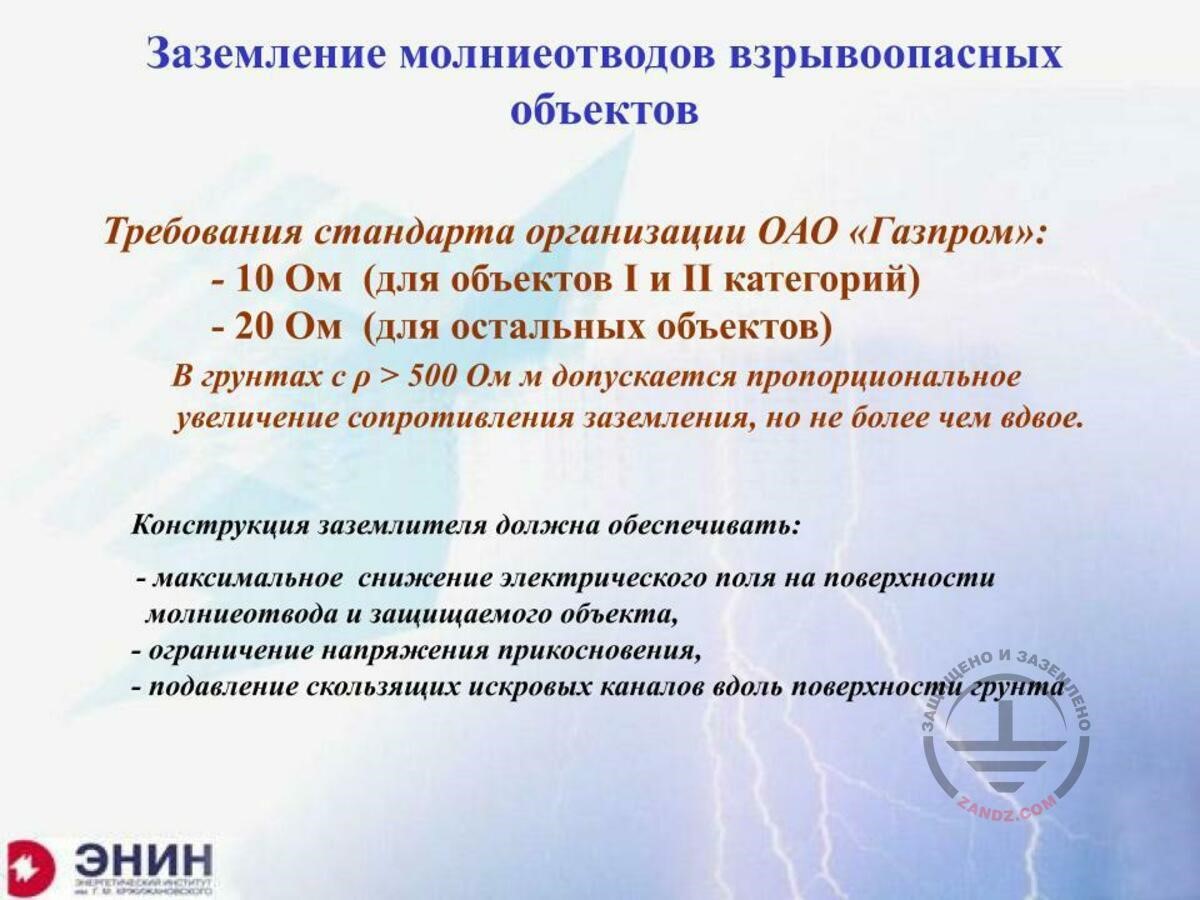
Earthing of lightning arresters of explosive facilities
| Заземление молниеотводов взрывоопасных объектов | Earthing of lightning arresters of explosive facilities |
| Требования стандарта организации ОАО «Газпром»: | Requirements of the standard of “Gazprom” OAO |
| - 10 Ом (для объектов I и II категорий) | - 10 Ohm (for facilities of Category I and II) |
| - 20 Ом (для остальных объектов) | - 20 Ohm (for other facilities) |
| В грунтах с ρ > 500 Ом м допускается пропорциональное увеличение сопротивления заземления, но не более чем вдвое. | In soils with ρ > 500 Ohm m, it is allowed to proportionally increase the earthing resistance but not more than 2-fold. |
| Конструкция заземлителя должна обеспечивать: | Structure of the earthing device must provide: |
| - максимальное снижение электрического поля на поверхности молниеотвода и защищаемого объекта, | - maximum reduction of the electrical field on the lightning arrester’s and the protected facility’s surface, |
| - ограничение напряжения прикосновения, | - limiting the touch voltage, |
| - подавление скользящих искровых каналов вдоль поверхности грунта | - suppressing creeping spark channels along the soil surface. |
Earthing of lightning arresters of explosive facilities. The regulatory base does not say a word about this. But if you examine the regulatory documents of the hydrocarbon fuel downstream and upstream producers, e.g., the "Gazprom" regulatory documents, then in this case, a standard of 10 Ohm for the second category facilities and a standard of 20 Ohm for the third category facilities are used. But these standards are weaker. If you have high-ohmic soils, if the soil resistivity is over 500 Ohm*m, these values begin increasing up to the double value. This is surely better than nothing. Of course, it is good to reduce the earthing resistance. Thus, the spark channels length is also reduced, which go along the soil surface, and you also provide safety for the people by reducing the step and touch voltage. This is good but you cannot achieve the significant effect by reducing the earthing resistance. Because the risk of ignition of the explosive mixtures over the tank farms still remains. But if you do not provide a reliable fire barrier system, you will not be able to solve the fire safety task.
| Разделительные разрядники для молниезащитного уравнивания потенциалов | Isolating arresters for potential equalizing to provide lightning arrester |
Now, one more point associated with the SDPs use. Where do SDP allow solving the fire safety issue? Once, in the territory of the Russian Federation, and for even more cramp reason, in Belarus, such thing happened: the gas distributing points exist, to which the high-pressure gas pipe is connected, and then from this gas distributing device, the gas pressure is reduced and transmitted along the pipelines to the consumers, e.g., to the private houses. These gas distributing points were often damaged by the fire caused by the lightning strike. How did that happen? The high-pressure pipelines are protected against corrosion using the electrochemical devices, i.e. a constant voltage is supplied to them. To avoid overloading of such chemical protection systems, the low-voltage pipes are not protected and, therefore, in the locations wherein the high-pressure pipeline is connected to the gas distributing device, an isolating paronite washer is installed that does not allow the chemical protection current to enter the low voltage grid. What happens when the lightning goes to the high-pressure pipeline? It reaches such isolating paronite washer, blocks this washer, and the gas-generating paronite washer generates gases. As a result of this, the volatilization of the plastic material occurs, high pressure is created, and the seal is damaged. And the gas outbreaks from the high-pressure pipeline and is ignited by this lightning discharge. Only half-burnt steel structures remain from the gas distributing point. What should we do? We have to provide a connection between the high-pressure pipe and the low-pressure pipe. But such connection must only operate upon the occurrence of high voltage associated with the lightning current spreading. To do this, the SDP is installed in its explosion-proof design that does not allow the breakage of the paronite seal. Such a simple device provides a beneficial effect.
| Разделительные разрядники для молниезащитного уравнивания потенциалов | Isolating arresters for the potential equalizing to provide lightning protection |
| Применение во взрывоопасных зонах | Use in the explosive zones |
| Ленточные хомуты для взрывоопасных зон | Band clamps for the explosive zones |
| Не возникает искрения при протекании токов до 50 кА (10/350 мкс) | No spark formation upon flowing of currents of up to 50 kA (10/350 mcs) |
| Для применения во взрывоопасных зонах 1 и 2 (газы, пары, взвеси), 21 и 22 (пыли) | To use in explosive zones 1 and 2 (gases, vapors, mists), 21 and 22 (dusts) |
One more option is available when you need to install the clamps on the pipes to install the SDP. The clamps are also made in the explosion-proof design. The SDPs are installed here, and, as a result, the breakthrough of the paronite seal is eliminated and thereby the explosion of the gas emitted into the interior volumes of such devices
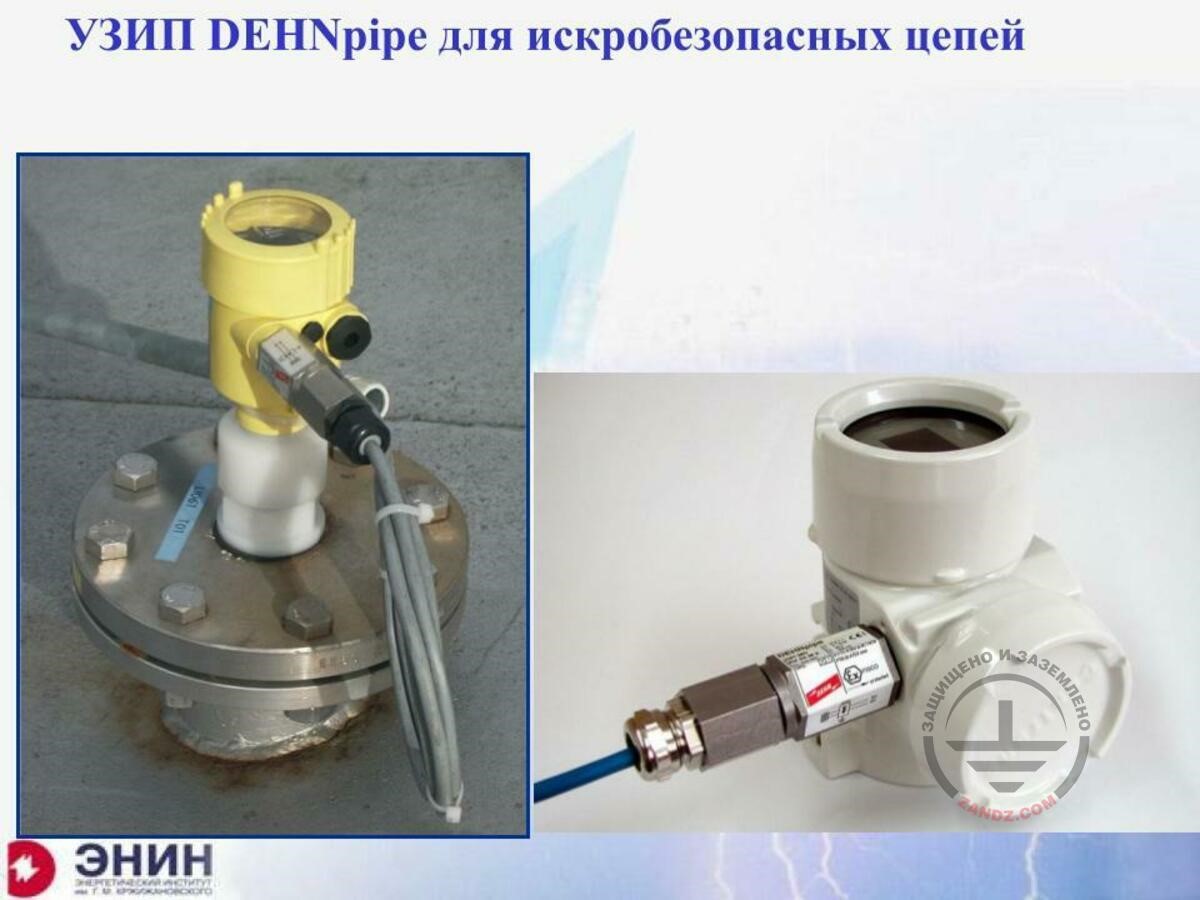
DEHNpipe SDPs for spark-proof circuits
| УЗИП DEHNpipe для искробезопасных цепей | DEHNpipe SDPs for spark-proof circuits |
The use of such spark-proof SDPs is a very good way to eliminate the breakthrough possibility in the volume that must exclude the breakthrough into the external space. And the use of such SDPs is a very efficient means to completely exclude the risk of any explosions and fires. Cost? You know, the recent development of such device I have seen was the device for 200 kA. I am not sure that we need to use the SDPs with the capacity of 200 kA in all cases, because the probability of such current is about 0.1%. And if you take into account that the lightning will not strike near this point but somewhere in the pipe, and some part of this current will be able to flow. Therefore, probably, we can install SDPs for 100 kA, and such SDPs are somewhat cheaper, because they are expensive because of their spark-proof design, but these SDPs do not require the device for limiting the follow current. Because there is no follow current there, if you do not consider a very small short circuit current provided by the chemical protection device. This current has a value of twenty amperes at most. And such devices are not so expensive and, therefore, I think that their use is acceptable. Probably I will finish at this point. If you have any questions, I will try to answer them. If I do not answer some questions, we will act as usual. Send all of them to me and I will answer all the questions I can. Do we have questions, Anatoly?
– Yes, we have, Eduard Meerovich.
– Read them to me.
Questions and answers
– Probably you have answered this partially, but Alexey wanted to clarify: "What SDP class should we install between high- and low-pressure pipes?"
– I will tell you the following thing once again. In principle, the current that goes to such SDP, may reach up to 200 kA. The probability of such current, once again, is about 0.1%. And this will be in the case that the lightning strike will occur immediately before the gas distributing point. If it occurs at some distance from the gas distributing point, perhaps, at the distance of only 100 meters, only 20 to 30% of the current will reach it. Therefore, if you have run out of money or if you do not want to install the expensive equipment, then I think, we can assume the current of 50 kA or even 100 kA. I highlight again that these SDPs are cheaper because they do not almost require arc suppression for the follow current. The follow current is provided there only by the electrochemical protection generator, and this current is very small. The next question, if any.
– It is very simple. The Russian regulatory documents lack them at all. I mean the national documents. They do not contain any requirements to the earthing resistance. Why? I will explain. IEC 62.305 standard refers to typical structures only. No explosive facilities are covered by IEC 62.305 standard. Therefore, the earthing resistance standards contained therein depend on the soil resistivity. There is a chart there. They do not refer to the explosive facilities; the standard does not cover them. Now, our regulatory document of 2003, SO-153, does not contain any requirements to the earthing resistance. Document RD 34 does not contain the requirements to earthing resistances, but it contains the requirement to the earthing devices structure. The structures as a combination of rod and wire lightning arresters are provided therein, and such structures may be used in any soils, whether 100 Ohm*m or 3,000 Ohm*m, because their designs are the same. And in this case, the earthing resistance differs by 30–40 times. In other words, our national regulatory documents do not specify any requirements to the lightning protection of the explosive facilities. Where are they described? Once again, they exist, e.g., in the "Gazprom" standard. It contains the requirements indicating the earthing resistance for the explosive facilities. 10 Ohm is for the first and second categories, and 20 Ohm is for the third category. Then, the simplified description is provided that such earthing resistance may be increased up to the 2-fold value depending on the earthing resistivity. There are the linear formulas provided. This is probably the only thing we can refer to today, but I will repeat. The change in the earthing resistance may change the fire hazard of the facility not very dramatically. It is slightly reduced due to the decrease in the spark channels length that penetrate the area wherein the objects that can burn exist. But this is probably it. The use of reduction in the earthing resistance for decreasing the fire risk is not a very efficient measure.
– Good, thank you! Dear colleagues, please send your questions in the chat. If we do not even have time to answer some questions, we will process them and send to Eduard Meerovich and after that provide answers to you. Or you may send them to e-mail. I will send a link in the chat. We have got 5 more minutes. The next question is: "Is it important to install the current collectors from different sides of buildings/structures?"
– Thank you. I can say that if we are talking about the electromagnetic interference, and we have to do that for the following reason. Because the electromagnetic interference is what may cause sparks in the building interior volume. If an explosive environment exists and you have got some circuit, then the electromotive force of magnetic induction occurs there. If there is a gap, then a spark occurs there. This spark will surely burn everything out that is located there. From this point, it is important to install current collectors evenly along the building's length. Why? It is very simple. Here, you have two current collectors. A current flows along one of them and along the other. Magnetic fluxes of these two current collectors here, in the internal volume, are oppositely directed and, as a result, the total magnetic flux is reduced. And if you have many current collectors, they will be more or less evenly spaced along the external building wall perimeter. And the electromagnetic environment will be significantly improved. Therefore, it is desirably to place the current collectors more or less evenly. This is the answer. Any more questions?
– Thank you. Yes, we have got two.
– Read them to me.
– You are correct. The grid has one good thing. First, we have no reason to fight with Gostekhnadzor. It is better to just install the grid. What is its benefit? It does not protect against the lightning. But what does it do? Distributes the lightning strike current more or less evenly among the current collectors. And I tell you that the current collectors should be more or less evenly installed along the building perimeter, but we also have to distribute the current among these current collectors evenly. If you have got a grid, then through this grid, the current will be more or less evenly distributed. I would use the grid for this reason and because of Gostekhnadzor. But if you need to protect the roof because it requires the protection of the coating itself. It is expensive, it is flammable, and it performs some process functions, then you surely need to install current collectors. And this is done in many cases. In the previous webinar, I showed you the photos made on the roof of an industrial building, a workshop, in Germany. There, such current collectors of about 3 meters high are spaced with a 5-meter step along the entire building perimeter and provide the reliable protection for this building and also of the climate control devices that are installed on the roof of the building. And certainly, in this case, they have got some potential. And due to their small height they are only connected using bolts. Welding is not used there. Mounting and dismounting of such current collectors takes 5 minutes for each current collector. And you should not save money on that. Any more questions? Let's do it!
– Several participants asked the same question: "We would like to know your opinion on the active lightning protection, the active lightning arresters. What do you think about it?"
– We already discussed this issue many times. We had a webinar for this lightning protection. My opinion is that no person that knows physics and is engaged in lightning protection seriously, has an argument in favor of using active lightning arresters. But there are many reasons against. And the most important reason I can say is the following. In the New Mexico University in the United States, six active lightning arresters and six conventional lightning arresters of the same height were installed on the 3-kilometer high mountain having a flat top. It is a so-called table rock. And the researchers have observed it for two years. As a result, the lightning arresters received 13 lightning strikes, and all out of 13 got to the typical lightning arresters. The active lightning arrester did not take any strike. This report of Moore and Rison, the experts from the New Mexico University, puzzled even the experts until the moment when these questions have been explained recently. They have been explained in the Russian experiments. The Russian experiments showed that nothing else could exist. The so-called active lightning arresters have a lower efficiency for the lightning attraction. You must not install them. This is my answer.
– Let's read the final question. All other questions will be examined later, if there are any. "What are the optimal ratios between the facility and the lightning arrester's heights? Are there such ratios?"
– In general, there are such ratios. Because, in the Russian standards, the lightning arrester should have a minimal elevation over the protected facility, the height of which in Russia is standardized. It is specified in the protection zones, which are, for example, provided in regulatory document SO153 of 2003. It states that in order to provide a good and more or less acceptable protection reliability, i.e. at the level of 0.9, the lightning arrester should exceed the facility for about 15% of its height. But these values refer only to single or double lightning arresters. If this lightning arrester system is multiple, such as the one we have just discussed, when ten lightning arresters are installed along the building perimeter, then these requirements become significantly lower. And we cannot talk particularly about the minimum elevation of lightning arresters over the facility because we have to take into account, first, the number of lightning arresters, and second, their spacing, and third, the surface area on the roof to be protected. Only a software can be used for this. I have answered.
– Thank you! Dear colleagues, thank you for the participation in the webinar.
– Anatoly, any more questions?
– We have got some, but we have run out of time, and I suggest to examine other questions in writing.
– OK. Then, dear colleagues, thank you very much for your attention! I want to tell you that, during the next webinar, we have to talk about the lightning protection’s future. Everybody have magnificent hopes regarding them. But since I am not young, I am rather sceptical about the lightning protection development. And the things I have to discuss at the next webinar; I ask you to bear in mind that it will be my personal opinion that may contradict yours. Please be critical about my words. Thank you again for your attention! Good-bye!
— Thank you! Bye!
| СПАСИБО ЗА ВНИМАНИЕ | THANK YOU FOR ATTENTION |
<< Previous page
slides from 10 to 17
Related Articles:
 5. Boundary between soil and air
5. Boundary between soil and air
 6. How to do that?
6. How to do that?


